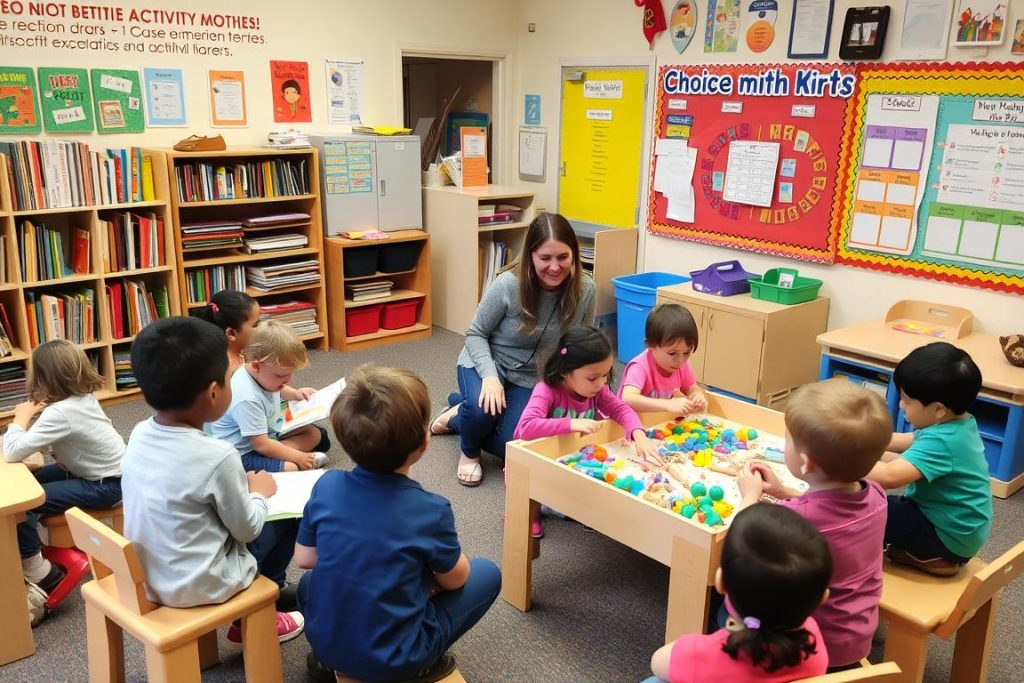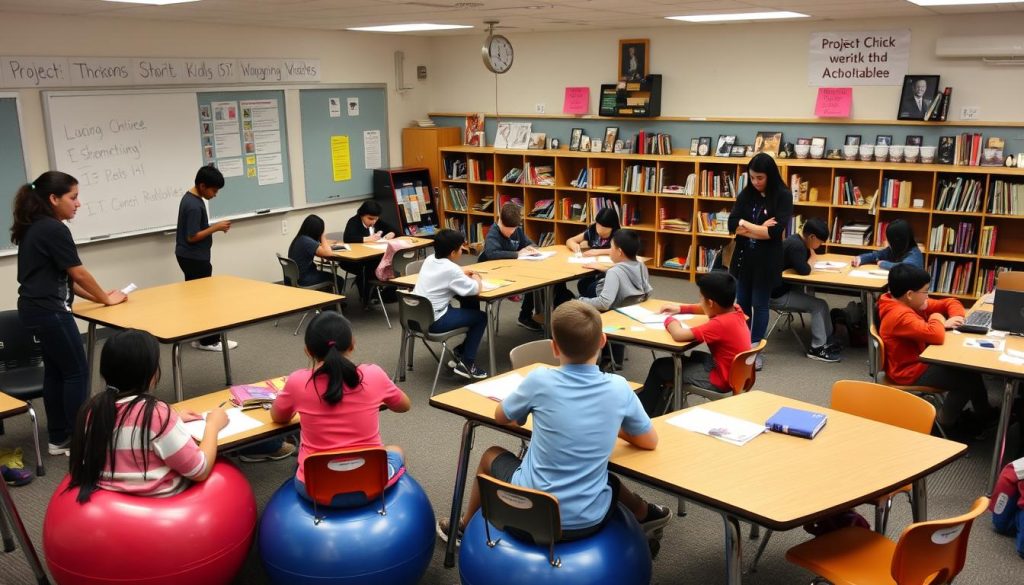Understanding the Importance of Student Choice in Education
Student choice is far more than simply offering options. It represents a fundamental shift in how we approach teaching and learning. When we talk about student choice, we’re referring to empowering students to have input on what they learn, how they learn it, and how they demonstrate their understanding. This approach recognizes students as active participants rather than passive recipients in the educational process.
The concept of student choice is grounded in research on motivation and engagement. According to research published in the Journal of Educational Psychology, when students have choices in their learning, they demonstrate increased motivation, greater persistence, and better performance. This connection between choice and engagement is why developing teacher skills in facilitating student choice has become increasingly important in modern education.
Student choice can take many forms across grade levels:
- Allowing students to select reading materials that interest them
- Providing options for how to complete assignments
- Letting students choose partners or groups for collaborative work
- Offering choices in assessment methods
- Involving students in classroom decision-making
- Creating flexible seating arrangements
Each of these approaches requires specific teacher skills to implement effectively, but the benefits for student learning make the effort worthwhile. As we explore the importance of student choice throughout this article, we’ll examine practical strategies for implementation across all grade levels.
The Importance of Student Choice for Motivation and Engagement
One of the most compelling reasons to incorporate student choice into your teaching practice is its profound impact on motivation and engagement. When students feel they have a say in their learning, they develop a sense of ownership that naturally leads to increased investment in the learning process.

Research consistently shows that student choice is directly linked to intrinsic motivation. According to Self-Determination Theory, developed by psychologists Deci and Ryan, humans have three basic psychological needs: autonomy, competence, and relatedness. Student choice directly addresses the need for autonomy, giving students a sense of control over their learning environment.
The benefits of implementing student choice include:
Academic Benefits
- Increased time on task
- Higher quality work production
- Improved retention of information
- Greater willingness to tackle challenging material
- Development of critical thinking skills
Social-Emotional Benefits
- Enhanced sense of responsibility
- Improved self-regulation
- Increased confidence
- Better classroom community
- Reduced behavior issues
Developing the teacher skills necessary to facilitate meaningful choice requires understanding how to structure options that are manageable yet meaningful. As noted by researcher Carly Robinson, providing too many choices can actually decrease motivation and satisfaction. The sweet spot appears to be offering 3-5 options, which provides sufficient autonomy without overwhelming students.
Enhance Your Teacher Skills in Student Choice
Looking to develop your expertise in implementing student choice? Our professional development course offers practical strategies you can use immediately in your classroom.
Practical Strategies for Implementing the Importance of Student Choice
Implementing student choice effectively requires specific teacher skills that evolve with experience. The good news is that you don’t need to completely overhaul your teaching approach overnight. Starting with small, manageable choices can yield significant benefits while allowing both you and your students to adjust to this more student-centered approach.
Elementary Grades (K-5)

In the early grades, developing teacher skills for implementing choice begins with simple but meaningful options:
- Voting and Decision-Making: Even at the preschool level, students can vote on which book to read during story time or which activity to do at recess. This introduces the concept of choice while building community decision-making skills.
- Choice Time: Designate specific periods during the day when students can choose from various learning centers or activities. These might include a reading corner, art station, math games, or science exploration area.
- Classroom Jobs: Allow students to apply for classroom responsibilities that interest them. This builds ownership and investment in the classroom community.
- Reading Choices: Provide a selection of books at appropriate reading levels and let students choose what they want to read during independent reading time.
Middle Grades (6-8)

As students mature, the teacher skills needed to facilitate choice evolve to include more complex decision-making:
- Flexible Seating: Allow students to choose where they work best, whether at traditional desks, standing tables, floor cushions, or other options.
- Co-created Classroom Norms: Involve students in developing the rules and expectations for the classroom, fostering ownership and responsibility.
- Choice Boards: Create menus of learning activities that address the same standards but through different modalities, allowing students to select the approaches that work best for them.
- Project Options: When assigning projects, provide options for both content focus and presentation format.
High School (9-12)
At the high school level, advanced teacher skills enable more sophisticated implementation of student choice:
- Reading Selection: Move beyond assigned texts to allow students to choose literature that interests them while still addressing key standards and skills.
- Assessment Options: Provide multiple ways for students to demonstrate mastery, such as traditional tests, projects, presentations, or multimedia creations.
- Learning Pathways: Create opportunities for students to set their own learning goals and determine how they’ll reach them, with teacher guidance.
- Structured “Recess”: Even high school students benefit from unstructured time. Consider implementing short breaks where students can choose refreshing activities.
“Want to know how to engage students, enthuse them, and bring out their best effort? Give them a voice in their decisions. In a society that barely listens to each other, listen to your students.”
Implementing these strategies requires developing specific teacher skills, including facilitation, organization, and the ability to balance structure with freedom. The most effective teachers recognize that student choice doesn’t mean complete freedom—it means thoughtfully designed options within appropriate boundaries.
Balancing Structure and the Importance of Student Choice
One common concern teachers express when considering student choice is the fear that classroom management will suffer. Developing the teacher skills to balance structure and choice is essential for successful implementation. The good news is that student choice, when implemented thoughtfully, often improves classroom management rather than undermining it.
The key is understanding that student choice doesn’t mean unlimited options or complete freedom. Instead, it means providing meaningful choices within appropriate boundaries. Here are some strategies for striking this balance:
Setting Clear Parameters
Establish clear expectations and requirements for any choice-based activity. For example, when offering project options, specify the learning standards that must be addressed, the timeline for completion, and the criteria for success.
Scaffolding Choice
For students who struggle with decision-making, start with limited options (perhaps just two choices) and gradually expand as their decision-making skills develop. This scaffolding approach is an important teacher skill for supporting all learners.
Teaching Decision-Making Skills
Explicitly teach students how to make good choices by modeling decision-making processes and providing opportunities for reflection on the outcomes of their choices.
Maintaining Accountability
Implement systems for tracking progress and ensuring that students are using their choice time productively. This might include check-ins, progress tracking tools, or peer accountability partners.
Research Insight: The “Sweet Spot” for Choice
According to research by Patall, Cooper, and Robinson (2008), offering 3-5 options appears to be the ideal number for maximizing the benefits of choice while avoiding choice overload. Too few options feels constraining, while too many can be overwhelming and lead to decision paralysis.
Many teachers find that developing the teacher skills to implement student choice actually improves classroom management. When students are engaged in activities they’ve chosen and feel ownership over, they’re more likely to be on-task and less likely to disrupt the learning environment. Additionally, when students have a voice in establishing classroom norms and procedures, they’re more invested in following them.
Master the Balance of Structure and Choice
Enhance your teacher skills with our professional development opportunities focused on implementing student choice while maintaining effective classroom management.
The Importance of Student Choice for Differentiation and Inclusion
One of the most powerful aspects of student choice is its natural alignment with differentiation and inclusive teaching practices. When we develop teacher skills for implementing choice effectively, we create learning environments that can accommodate diverse needs, abilities, and interests.
Student choice naturally supports differentiation in several key ways:
- Multiple Entry Points: When students can choose how to approach learning, they naturally gravitate toward entry points that match their readiness levels.
- Interest-Based Engagement: Choice allows students to connect learning to their personal interests, increasing motivation and persistence.
- Learning Style Accommodation: Options for visual, auditory, kinesthetic, and reading/writing approaches can be built into choice activities.
- Pace Differentiation: Student choice often allows for variations in pacing, giving students the time they need to process and master content.
For students with disabilities, choice can be particularly empowering. Research indicates that choice can help develop self-determination skills, which are crucial for long-term success. The teacher skills needed to implement choice for diverse learners include understanding how to provide appropriate scaffolding while still maintaining meaningful options.
“Student choice allows for differentiated instruction, which is important in special education classrooms where students may have a wide range of abilities and needs. By offering choices, teachers can better meet the interests and needs of individual students while providing opportunities for all students to demonstrate their learning and be successful.”
Practical Strategies for Inclusive Choice
For Students with Learning Disabilities
- Offer choices in how information is accessed (text, audio, video)
- Provide options for demonstrating knowledge (written, oral, visual)
- Allow choice in tools and supports (graphic organizers, technology)
- Create flexible timelines when possible
For English Language Learners
- Include choices that incorporate home language and culture
- Offer options with varying language demands
- Provide visual and hands-on choices
- Allow for collaborative options that support language development
Developing the teacher skills to implement inclusive choice practices requires ongoing learning and reflection. It’s important to regularly assess whether the choices you’re offering are accessible to all students and make adjustments as needed.

By prioritizing the importance of student choice in your teaching practice, you create natural opportunities for differentiation that benefit all learners. This approach recognizes and celebrates the diversity of your classroom while providing appropriate challenges and supports for each student.
Assessing Learning in Environments That Value the Importance of Student Choice
When implementing student choice, assessment practices must evolve to align with this more personalized approach to learning. Developing teacher skills for assessment in choice-based environments requires moving beyond traditional one-size-fits-all tests to more flexible and authentic evaluation methods.

Here are effective approaches to assessment that honor student choice while maintaining academic rigor:
Rubrics and Success Criteria
Clear, standards-based rubrics provide a consistent framework for assessing diverse projects and products. When students understand the criteria for success from the beginning, they can make informed choices about how to demonstrate their learning while still meeting key standards.
Portfolio Assessment
Portfolios allow students to collect evidence of their learning over time and across different choice-based activities. Digital portfolios make it easy for students to include various media types, reflecting the diverse ways they’ve chosen to engage with content.
Student Self-Assessment
When students have choice in their learning, self-assessment becomes a natural extension of the process. Developing teacher skills to guide meaningful self-reflection helps students take ownership of their progress and identify areas for growth.
Conferences and Interviews
One-on-one conferences provide opportunities to discuss student choices, process, and learning outcomes. These conversations yield insights that might not be evident in the final product alone.
How do I ensure students are meeting standards when they’re all doing different things?
The key is to start with clear learning targets and design choice options that all address these same targets, just through different pathways. A well-designed rubric that focuses on the essential skills and knowledge, rather than specific project features, allows for consistent assessment across varied student work.
Won’t some students choose the easiest option every time?
This is where developing specific teacher skills for guiding choice comes in. By designing options that are equally challenging but in different ways, you can avoid having an “easy way out.” Additionally, conferencing with students about their choices helps them reflect on their decision-making and encourages them to challenge themselves appropriately.
Remember that assessment in choice-based environments should focus on both the product and the process. The choices students make, how they navigate challenges, and their reflections on their learning are all valuable data points that inform your understanding of their growth.
Develop Advanced Teacher Skills for Assessment
Our professional development course on “Assessment in Choice-Based Classrooms” provides practical strategies for evaluating diverse student work while maintaining high standards.
Embracing the Transformative Importance of Student Choice

The importance of student choice extends far beyond immediate classroom engagement. When we empower students to make meaningful decisions about their learning, we prepare them for a future that will demand self-direction, critical thinking, and adaptability. By developing the teacher skills necessary to implement choice effectively, we create learning environments that honor student agency while maintaining high academic standards.
As you consider incorporating more student choice into your teaching practice, remember that this is a journey. Start small, reflect often, and be willing to adjust your approach based on what you learn. The most successful implementations of student choice come from teachers who view themselves as learners alongside their students, continuously refining their teacher skills through experience and professional development.
The research is clear: when students have appropriate choices in their learning, engagement increases, motivation deepens, and learning outcomes improve. By embracing the importance of student choice across all grade levels, you’re not just improving academic results—you’re helping to develop confident, self-directed learners who are prepared for success in school and beyond.
Take the Next Step in Your Professional Growth
Ready to transform your classroom through student choice? Our comprehensive professional development program provides the teacher skills, resources, and support you need to implement effective choice-based learning.




